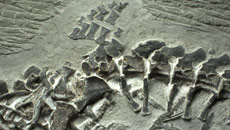What exactly did people living along the banks of the Nile river thousands of years ago exactly eat? New research has unlocked the secret: Like most modern people, their diet was wheat and barley-based.
"We worked a lot with bones and teeth, while most researchers study hair, collagen and proteins. We also worked on many different periods, with not many individuals for each period, so we could cover a very long time span," said lead researcher Alexandra Touzeau from the University of Lyon.
The main conclusion of the research was that cereals like millet and sorghum were only a minor part of the diet - less than 10 percent.
The team looked at carbon atoms in mummies that had lived in Egypt between 3,500 BC and 600 AD.
The mummies that the French researchers studied were the remains of 45 people that had been shipped to two museums in Lyon, France during the 19th century.
They measured carbon-13 to carbon-12 ratios in bone, enamel and hair in these remains and compared them to similar measurements performed on pigs.
As pigs have a metabolism similar to humans, their carbon isotope ratios were compared to what was found in mummies.
Hair absorbs a higher rate of animal proteins than bone or teeth, and the isotope ratios in hair of the mummies corresponded to that found in hair of modern European vegetarians - confirming that ancient Egyptians were also mainly vegetarians.
This showed that the ancient Egyptians adapted well to the environment, while the Nile region became increasingly arid between 3500 B.C. and 600 A.D.
And surprisingly, there appears to have been little fish in their diet, said the study published in the Journal of Archaeological Science.





